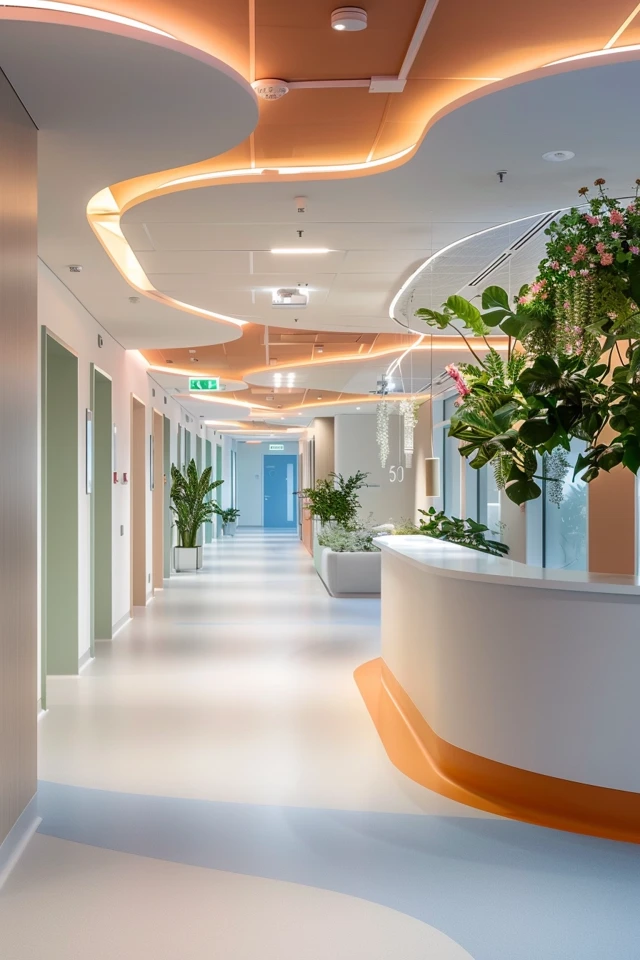Creating a welcoming and functional healthcare space is crucial. A well-thought-out clinic design boosts patient comfort and experience. Ceilings, often ignored, play a key role in enhancing the hospital’s mood and the well-being of everyone inside. Let’s explore five tips for designing hospital ceilings that foster a calming and healing environment:
1. Incorporate Optimal Lighting
Natural light can significantly improve mood and patient experience. It’s key to use a blend of different lighting types. This combination enhances the space, making it inviting and versatile.
2. Embrace Aesthetically Pleasing Designs
Ceilings offer a chance to make a design statement. Pick designs that soothe and please the eye. Selecting patterns, colors, and textures that reflect the hospital’s brand makes the environment cohesive and attractive.
3. Prioritize Infection Control
Choosing ceiling materials that are simple to clean is essential for health. Materials should be antimicrobial and easy to maintain, ensuring a safer space for everyone.
4. Ensure Flexibility
Designing ceilings with future modifications in mind is wise. Using flexible and easy-to-update solutions saves resources. This foresight makes adapting the space straightforward.
5. Consider Acoustic Solutions
Hospitals are often filled with noise. By adding acoustic improvements to ceilings, the environment becomes quieter. This enhancement leads to a more peaceful and healing atmosphere for patients.
Key Takeaways:
- Optimal lighting can enhance the mood and well-being of patients.
- Aesthetically pleasing designs contribute to a visually appealing environment.
- Prioritizing infection control with easy-to-clean materials is crucial.
- Design flexibility allows for future changes or expansions.
- Acoustic solutions can reduce noise pollution and create a quiet environment.

Key Considerations for Hospital Ceiling Design
Designing hospital interiors often skips over the ceiling. Yet, it’s crucial for patient comfort, workflow efficiency, and the hospital’s brand. Here are essential points for hospital ceiling design:
- Patient Experience: Putting patient experience first is vital. A thoughtfully designed ceiling can make the environment soothing. This helps lessen patient anxiety and stress.
- Infection Control: Infection control is a top priority in hospital design. Ceilings need to be easy to clean and resist microbes. They should also have antimicrobial features to cut down on infection risks.
- Workflow Efficiency: Hospitals are busy places where workflow matters a lot. Ceilings should support medical equipment and provide good lighting. It’s important to consider where things like HVAC and medical gas outlets will go.
- Branding and Identity: Ceilings can help show off a hospital’s brand. Using the hospital’s logo or colors in the design can make a space feel unified and distinct.
By paying attention to these elements, healthcare facilities can make better spaces. They can boost the patient experience, fight infections, improve workflow, and showcase their identity.
Tips for Hospital Ceiling Design
Designing hospital ceilings requires attention to several key factors. These include lighting, looks, upkeep, and the ability to change. Here are a few tips:
1. Prioritize Lighting:
Light plays a major role in hospital design. It shapes the mood of the environment. Aim to let in as much natural light as possible. Use windows or an Atrium. Make sure light fixtures provide enough light and enhance the space’s feel.
2. Embrace Aesthetics:
Aesthetic elements, though not the main focus, aid in patient comfort. Opt for calming colors like shades of blue. Choose ceiling materials that look good and foster healing.

3. Easy Maintenance:
Keeping hospital ceilings clean is crucial. Select materials that are simple to clean and stop germs from spreading. Stay away from hard-to-clean textiles. This helps in keeping the space safe and reduces upkeep work.
4. Flexibility:
Hospitals must easily adjust to new needs. Design ceilings that can change or upgrade without hassle. Use modular parts that can be rearranged. This makes it easier to keep up with advancements in healthcare.
These tips help design hospital ceilings that focus on necessary elements. They aim for a space that puts patient comfort first. It aids healing and improves the healthcare experience.
Conclusion
It’s key to design hospital ceilings with patient care as a priority. This leads to a better healing environment. By focusing on comfort, light, reducing germs, and using green practices, hospitals become more inviting. This improves the patient’s experience.
Adding ergonomic seats, great lighting, and calming colors in waiting areas makes patients more at ease. Using materials that block sound in exam rooms keeps conversations private. Good air flow and clean air systems, along with natural light and saving energy, are good for both the clinic’s feel and its budget.
Spaces friendly to families, using sustainable stuff, and designs that connect with nature enhance air and looks. Tech like touch-screens improve how patients get information. Areas for relaxation and aromatherapy help those looking for whole-body care. Versatile furniture and carefully chosen colors keep things calm and helpful.
By considering these design ideas, hospital settings can support healing. They also become more welcoming. This has a good effect on how patients feel about their care and happiness.

